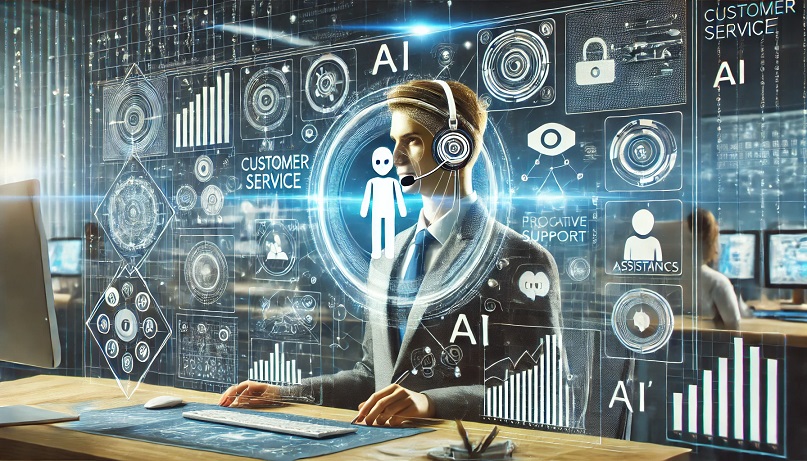AI is changing everything including customer services. It’s helping human agents work smartly, streamlining repetitive tasks, and enabling them to focus on solving complex problems and providing personalized support.
This shift has created new possibilities for businesses looking to improve efficiency while offering a more human touch where it counts.
For customer service teams, this means embracing new tools like AI-powered call management, automated workflows, and intelligent routing systems.
By handling simpler and repetitive tasks, AI allows human agents to invest their energy into high-value interactions, increasing job satisfaction and reducing burnout.
But how exactly is AI reshaping customer service jobs? Let’s look into some transformative ways it’s changing the game.
1. Enhancing Agent Efficiency
AI is transforming customer service by making agents more efficient. With the help of AI calling systems, agents no longer have to spend hours on repetitive tasks. AI can handle these tasks instantly.
For example, AI-powered tools can summarize customer interactions, freeing agents to focus on solving more complex issues. Agents have more time to deal with customers who need personalized attention, making the service faster and more effective.
By automating routine work, AI also helps agents perform their jobs better. AI can provide real-time suggestions during calls, guiding agents to make decisions faster.
It can even analyze the tone of a customer’s voice to help agents adjust their approach based on the customer’s mood.
This ensures agents are not only working faster but also providing a more tailored experience for every customer.
As a result, businesses can resolve more issues in less time, increasing both productivity and customer satisfaction.
With AI managing the backend work, agents are free to do what they do best—offering thoughtful, human-centered solutions
2. Optimizing Workforce Management
Managing a customer service team can be challenging, especially when predicting busy periods and scheduling agents accordingly. This is where AI shines.
By analyzing historical data and customer interaction trends, AI can forecast peak times and ensure the right number of agents are available to handle the workload.
With AI workforce management tools, companies can better anticipate when they need extra support. This minimizes wait times and improves the overall customer experience.
AI helps with forecasting and also automating shift planning. Instead of managers spending hours manually creating schedules, AI can generate optimized rosters that consider factors like employee preferences, past performance, and predicted customer demand.
This leads to a more balanced workload, higher employee satisfaction, and a reduction in costly overtime.
Moreover, when unexpected spikes in demand occur, AI can make real-time adjustments, helping managers avoid bottlenecks and keeping customer service operations running smoothly.
The result? A more efficient team that can meet customer needs faster, boosting both productivity and customer satisfaction.
3. Improving Customer Satisfaction Through Intelligent Routing
Have you ever been frustrated by being bounced between customer service agents? AI is putting an end to that with intelligent routing.
This technology analyzes customer requests in real-time and directs them to the most suitable agent based on their needs, language, or even previous interactions.
By making sure the right agent handles the right query, intelligent routing cuts down on wait times, reduces the number of transfers, and gets customers the answers they need faster.
What’s even better is that AI doesn’t just stop at routing based on skill. It can detect a customer’s mood or urgency by analyzing their tone of voice or the keywords they use. It means if someone is particularly frustrated, the system can prioritize their call and route them to an experienced agent who can handle the situation effectively.
This kind of precision leads to happier customers who feel valued and understood from the moment they make contact.
With AI-driven routing, companies not only streamline operations but also improve customer satisfaction. It’s a win-win situation where customers get quick resolutions, and businesses see higher efficiency and more positive feedback.
4. Reducing Training Time and Accelerating Onboarding
Training new customer service agents can be time-consuming and costly. AI is changing that by streamlining the onboarding process and significantly reducing the time it takes to get agents up to speed.
AI tools can provide real-time feedback and personalized training to new hires, helping them quickly adapt to the role.
For example, AI-driven platforms can analyze customer interactions, identify key areas where an agent needs improvement, and offer suggestions on how to handle future conversations.
AI can also automate parts of the training that would typically take days or even weeks. By providing instant access to knowledge bases and step-by-step guidance, new agents can learn at their own pace without needing constant supervision.
This accelerates the onboarding process and empowers agents to handle tasks confidently and independently.
Moreover, AI can help new agents perform better on the job by offering real-time suggestions during calls. If an agent is struggling with a difficult customer, AI can suggest phrases or solutions to keep the conversation on track.
The instant support builds confidence and ensures that even new agents can deliver top-tier service from day one
With AI reducing training time, businesses save resources, and agents can start contributing to customer satisfaction sooner.
5. Proactive Customer Support
Imagine solving a customer’s problem before they even know it exists. That’s the power of proactive customer support, made possible by AI.
Instead of waiting for new issues, AI can predict potential problems by analyzing customer behavior, patterns, and feedback. This allows businesses to address issues before they escalate, leading to higher customer satisfaction and fewer complaints.
AI tools can monitor trends across customer interactions and alert teams when something seems off.
For instance, if several customers are experiencing similar problems, AI can detect the pattern and prompt the service team to send out a proactive solution or notification.
This prevents issues from becoming widespread and keeps customers informed before they even need to reach out for help.
By anticipating customer needs, AI transforms how businesses interact with their clients. Customers feel valued and supported, which leads to stronger loyalty and trust.
Companies that adopt proactive support improve service and create lasting relationships with their customers. In an age where speed and efficiency are key, proactive customer support offers a significant competitive advantage.
The Bottom Line
AI is reshaping how businesses operate and how agents interact with customers. From enhancing efficiency and streamlining tasks to proactive support that anticipates customer needs, AI is transforming the industry in ways that benefit both businesses and their customers.
With AI handling the repetitive tasks, agents are free to focus on more meaningful interactions, resulting in faster resolutions and happier customers.
As customer expectations continue to rise, adopting AI-driven solutions is no longer an option but a necessity.
The businesses that integrate these tools effectively will not only improve their service operations but also create stronger, lasting relationships with their customers.
By embracing AI, companies can future-proof their customer service strategy and thrive in an increasingly competitive market.










